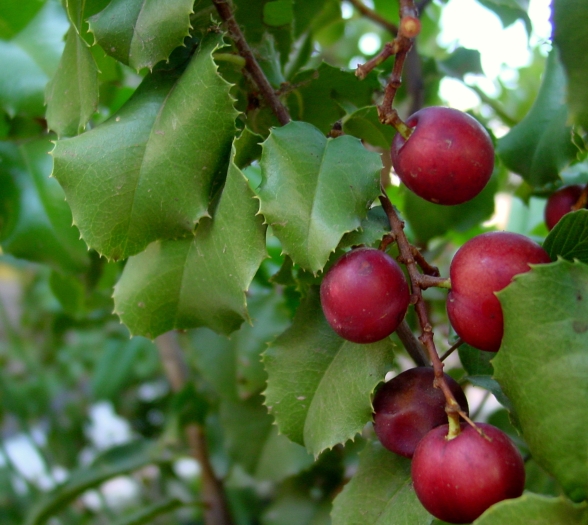Hollyleaf Cherry
(Prunus ilicifolia)
Hollyleaf Cherry (Prunus ilicifolia)
/
/

NoahElhardt assumed
CC BY-SA 2.5
Image By:
NoahElhardt assumed
Recorded By:
Copyright:
CC BY-SA 2.5
Copyright Notice:
Photo by: NoahElhardt assumed | License Type: CC BY-SA 2.5 | License URL: https://creativecommons.org/licenses/by-sa/2.5 | Uploader: NoahElhardt | Publisher: Wikimedia Commons | Title: Prunus_ilicifolia_ne1.jpg | Notes: |



















































Estimated Native Range
Summary
Prunus ilicifolia, commonly known as Hollyleaf Cherry, is an evergreen shrub or small tree that is part of the Rosaceae family. It is native to the chaparral and coastal sage scrub regions of California and Baja California, where it thrives in dry, rocky slopes and canyons. This species typically grows to a height of 8 to 30 feet (2.4 to 9.1 meters) and has thick, leathery leaves that are 1 to 2 inches (2.5 to 5.1 centimeters) in length, with a spiny, holly-like appearance. The small white flowers bloom in clusters from March to May and are followed by purple to black cherries that are sweet and edible, though they have a thin pulp around a large pit.
Hollyleaf Cherry is valued for its ornamental qualities, including its shiny, evergreen foliage and showy white flowers. It is a versatile plant used in urban landscaping, as a hedge or screen, and for its edible fruit. The plant is easy to grow from seed and can be pruned twice a year if shaped as a hedge. It prefers full sun but can tolerate part shade, and while it is drought-tolerant, young plants benefit from regular watering. The soil should be well-draining and can range from sandy to loamy. Hollyleaf Cherry is also appreciated for its ability to attract bees. Gardeners should be aware that while it is generally disease-resistant, it can suffer from pests like aphids and scale insects.CC BY-SA 4.0
Hollyleaf Cherry is valued for its ornamental qualities, including its shiny, evergreen foliage and showy white flowers. It is a versatile plant used in urban landscaping, as a hedge or screen, and for its edible fruit. The plant is easy to grow from seed and can be pruned twice a year if shaped as a hedge. It prefers full sun but can tolerate part shade, and while it is drought-tolerant, young plants benefit from regular watering. The soil should be well-draining and can range from sandy to loamy. Hollyleaf Cherry is also appreciated for its ability to attract bees. Gardeners should be aware that while it is generally disease-resistant, it can suffer from pests like aphids and scale insects.CC BY-SA 4.0
Plant Description
- Plant Type: Shrub, Tree
- Height: 3-16 feet
- Width: 3-20 feet
- Growth Rate: Moderate
- Flower Color: White
- Flowering Season: Spring
- Leaf Retention: Evergreen
Growth Requirements
- Sun: Full Sun, Part Shade
- Water: Low, Medium
- Drainage: Fast, Medium, Slow
Common Uses
Bank Stabilization, Bee Garden, Bird Garden, Butterfly Garden, Drought Tolerant, Edible*Disclaimer: Easyscape's listed plant edibility is for informational use. Always verify the safety and proper identification of any plant before consumption., Erosion Control, Fire Resistant, Fragrant, Groundcover, Hedges, Low Maintenance, Rabbit Resistant, Salt Tolerant, Showy Flowers, Street Planting
Natural Habitat
Native to chaparral and coastal sage scrub regions of California and Baja California
Other Names
Common Names: Evergreen Cherry , Holly-Leaved Cherry , Islay
Scientific Names: Prunus ilicifolia , Lauro-cerasus ilicifolia
GBIF Accepted Name: Prunus ilicifolia (Nutt. ex Hook. & Arn.) D.Dietr.